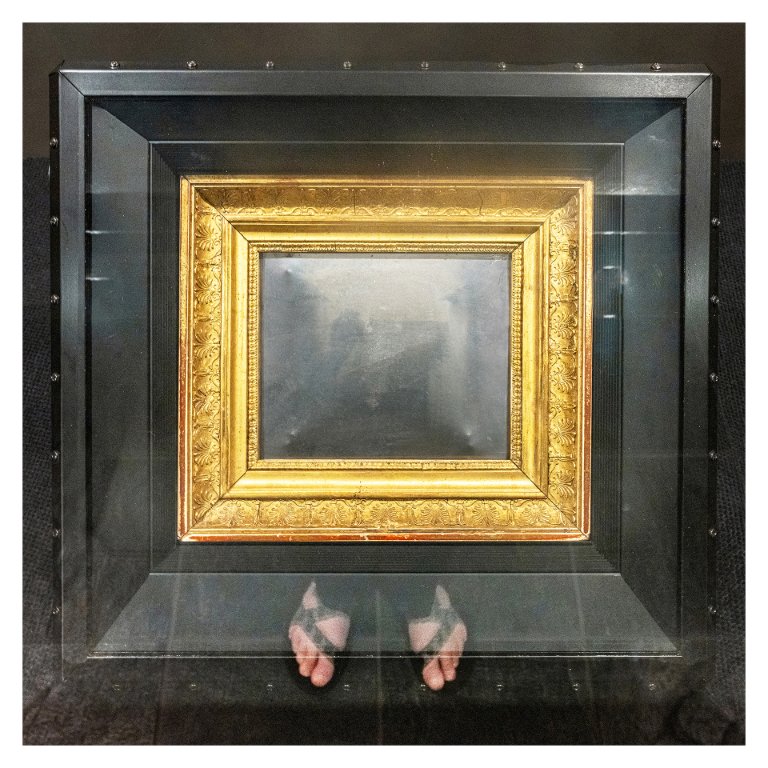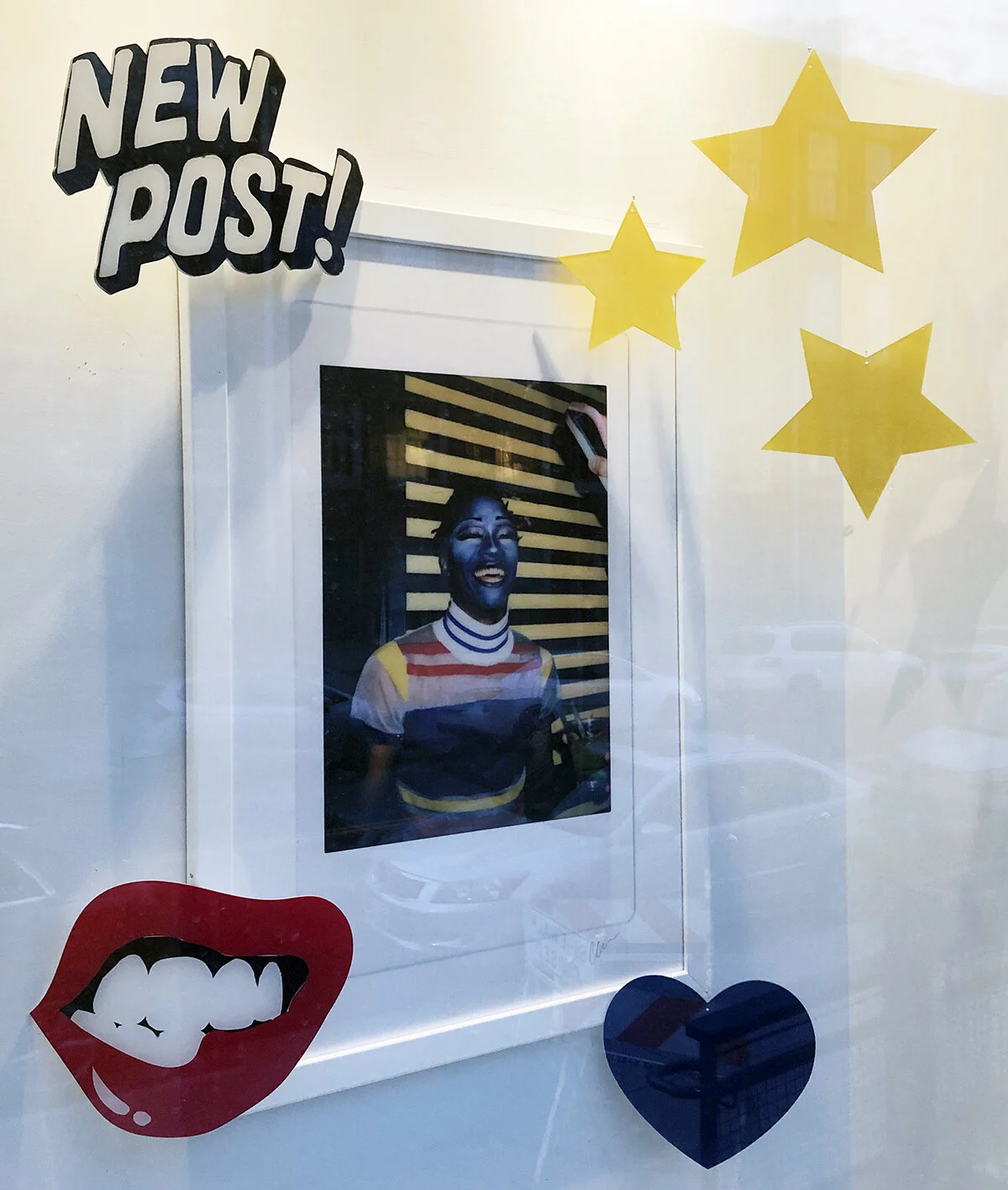Aging Bodies, Myths and Heroines
Aging Bodies, Myths and Heroines
East Window
4550 Broadway, Suite C-3B2, Boulder, CO 80304
November 9, 2023–February 28, 2024
Admission: free
Review by Madeleine Boyson
“Old age is not a diagnosis,” writes the surgeon Atul Gawande in his book Being Mortal: Medicine and What Matters in the End, discussing medical contexts past middle age. [1] He’s pondering individualism in the contemporary West and how we construct aging in our homes and hospitals. Yet, he continues, we persist in believing that old age is a disease to be fought and conquered. Amidst advertisements for anti-aging grails and fountains of youth, we perceive our elderly in one of two ways: those who miraculously defy age and those who succumb to it.
East Window’s front façade at 4550 Broadway in Boulder, Colorado, with a view of Sherry Wiggins and Luís Filipe Branco’s Death of Cleopatra (after Jean-Baptiste Regnault, 1796-97), 2023, photography/inkjet print on the entry wall. Image by Madeleine Boyson.
Aging Bodies, Myths and Heroines, a group show at East Window gallery in Boulder, on view through February 28, considers the space in between these tropes. Curator and gallery owner Todd Edward Herman has gathered “a small selection of playful, critical, and tender images made by and about elder artists” to shift perceptions from “the ‘pornography of old age’ within consumer culture” towards lived experience. [2] The resulting exhibition is heartfelt and substantive, even humorous, and successfully considers aging’s realities without devolving into pity or romanticization.
An installation view of Aging Bodies, Myths and Heroines at East Window. Image by Madeleine Boyson.
Several throughlines underpin Aging Bodies. The twelve artists in the show consider and complicate photography’s history, its role in codifying personal and collective memory, and the expectations for truth in a medium that ostensibly captures reality. Their works also preserve gentleness even as the artists acknowledge the permeability of time and the body. Aging Bodies reveals that by “upending” and leveraging photographic pretenses, there is more room to contemplate the myriad “self-images of the middle aged and old.” [3]
Marissa Nicole Stewart, excerpts from Call Me When You Get Home, 2022, photography/inkjet prints. Image by Madeleine Boyson.
Numerous works feature photographs of photographs, which reframe the medium’s chronology and show aging as part of kindred and creative ancestries. Marissa Nicole Stewart’s series Call Me When You Get Home (2022) focuses on matrilineage through oral history and identity. Stewart presents an endearing portrait of her grandmother, Lillie Gregory, alongside photos of a Cadillac sedan, a driveway, and memorabilia that track the artist’s personal history.
Marissa Nicole Stewart, excerpts from Call Me When You Get Home, 2022, photography/inkjet prints. Image by Madeleine Boyson.
The latter depicts school portraits, obituaries, handwritten notes, and photographs marked “contested,” which convey how the legacy of enslavement prohibits many Black Americans from tracing their ancestry with any certainty. Together, Stewart’s images ponder age as it relates to “the process to keep a family history intact when the systems it exists within are designed to keep it apart.” [4]
Will Wilson: John Gritts: Cherokee Nation, 2013, archival pigment print from wet plate collodion scan. Image courtesy of East Window.
Similarly, Will Wilson’s 2013 double portrait of John Gritts (Cherokee) holding a tintype of his great-great grandmother, Dockie Livers, interrogates legacies created by white photographers like Edward S. Curtis. Opposite in the gallery, Danielle SeeWalker and Carlotta Cardana display works from The Red Road Project (2013-present), which “examines what it means to be Native American in the 21st century.” [5]
Danielle SeeWalker and Carlotta Cardana, Ula and Tim Tyler (left) and Andy Jones (right) from The Red Road Project, 2013-present, inkjet prints. Image by Madeleine Boyson.
The artists pose older tribal members in their homes, often including personal and family photographs in the background. Resisting settler gazes like Curtis’s—which constrain Native subjects as “frozen in time”—and emphasizing kinship, Wilson, SeeWalker, and Cardana prompt viewers to consider photography’s role in colonialism and collective memory while connecting Indigenous elders across time and space. [6]
Roddy MacIness, Incontinence and diapers after prostate surgery. Discomfort and humility, our best teachers, 2022, archival inkjet photographic print. Image courtesy of the artist.
Roddy MacInnes also contemplates photography’s present as it relates to the past, but brings viewers inward, making images of prostate surgery recovery from an internal perspective. We join in staring at MacInnes’s mirrored belly scar and looking down at his incontinence pad.
Roddy MacIness, Self-portrat and Niépce’s Heliograph (oldest photograph still in existence, 2023, archival inkjet photographic print. Image courtesy of the artist.
But he also humors by pairing personal testimonies with another self-portrait of his feet reflected in the protective glass on Niépce’s Heliograph, the oldest surviving image made with a camera obscura. Like Joseph Nicéphore Niépce (1765-1833), himself almost seventy when he made this point de vue in 1827, MacInnes conducts photographic experiments to record life as the metaphors of aging become absurd, if painful, interludes along our histories.
Donigan Cumming, Untitled (May 3, 1989), from the series Pretty Ribbons, 1993, archival inkjet print. Image courtesy of the artist.
Donigan Cumming, Untitled (June 16, 1983), from the series Reality and Motive in Documentary Photography, Part 1, 1986, archival inkjet print. Image courtesy of the artist.
Elsewhere in the gallery, artists stage elaborate and playful images that confuse expectations for truth in the medium. Donigan Cumming, for example, scrupulously poses a laughing, naked elder next to an open fridge, and a clothed elder posing under the single bulb of a plainly featured bedroom. Here audiences must confront their own expectations of aging, considering whether these “voyeuristic” perspectives are indeed as “questionable” as our culture deems them. Regardless, as the exhibition text points out, we are “complicit participants” in this “fascination with physical and social decrepitude.” [7]
Mitchell Squire, gucci muthaf**ka, 2020, inkjet print. Image by Madeleine Boyson.
Mitchell Squire, by contrast, brings his aging body out of the home and into the wilderness, emphasizing vibrance and color. Here his two self-portraits explore “how a sixty-plus-year-old Black man might live increasingly unmeasured, uncensored, and ungoverned.” [8] In gucci, muthaf**cka, Squire stares at the viewer while reclining against fallen branches and covered in white and gold tinsel. His gaze is neither daring nor inviting, but embodies “a personal anarchy, an unwavering interiority,” and the view of an artist continuously grounding himself in life’s delicious glow. [9]
James Hosking, Donna Personna (3 excerpts), from the Beautiful by Night series, 2014, archival inkjet print (left) and Sherry Wiggins and Luís Filipe Branco, Cleopatra at the Cafe, 2023, archival inkjet print (right). Image by Madeleine Boyson.
Continuing these themes, photographs by James Hosking, Sherry Wiggins and Luís Filipe Branco, Magdalena Wosinska, and André Ramos-Woodard variously lean into honest, campy, tender, and sincere photographs of drag queens, Cleopatra reenactments, and portraits of family members living and dead. Whether by or about elders, all of the works in Aging Bodies create a safe place to see and be seen, to be honored without undue adulation or misplaced, pitying self-indulgence. The exhibition provides a new space between these mythologies, prompting viewers to acknowledge how we talk about and relate to our elders and ourselves as we age.
André Ramos-Woodard, Guardian (Hartense), from what it’s like to feel., 2023, digital collage and archival inkjet print. Image courtesy of East Window.
“Lacking a coherent view of how people might live successfully all the way to their very end,” Gawande continues, “we have allowed our fates to be controlled by the imperatives of medicine, technology, and strangers.” [10] But Aging Bodies, Myths and Heroines contests this notion, suggesting that as we see ourselves reflected—figuratively and even literally, within the protective glass—we may see our complicities, and alter them.
Madeleine Boyson (she/her) is an independent writer, curator, lecturer, and artist located in Denver, Colorado. Her scholarship concentrates on American modernism and (dis)ability studies, including issues of care and dependency as well as the wholeness of the body. She has a Bachelor of Arts Degree in Art History and History from the University of Denver.
[1] Atul Gawande, Being Mortal: Medicine and What Matters in the End (New York: Metropolitan Books, 2014), 40.
[2] From the exhibition introduction by curator Todd Edward Herman.
[3] Ibid.
[4] From the artist’s statement in the exhibition handout.
[5] From the exhibition handout.
[6] Ibid.
[7] Ibid.
[8] Ibid.
[9] Ibid.
[10] Gawande, Being Mortal, 18-19.

















![]MARGINS[](https://images.squarespace-cdn.com/content/v1/5dade78ef3de04278ab5b4e8/1706556791874-RM7RABP1MHJ4GM9S100G/orimo_notes45+%281%29.jpg)


